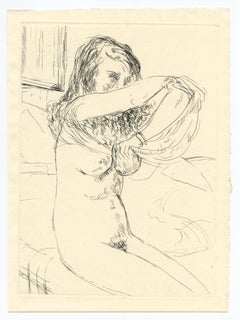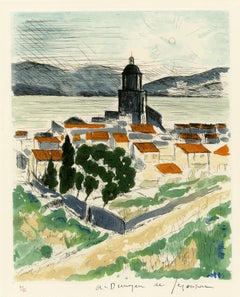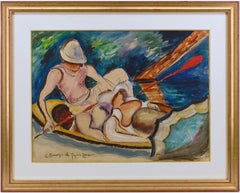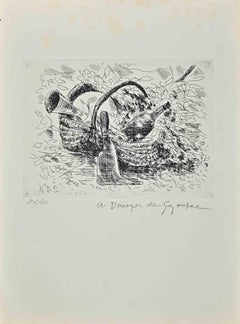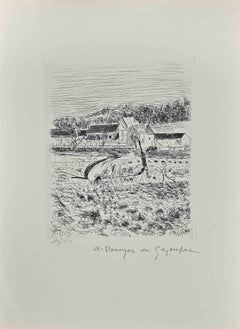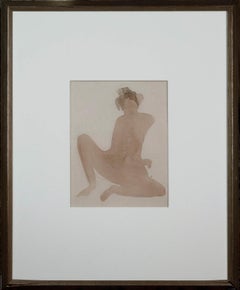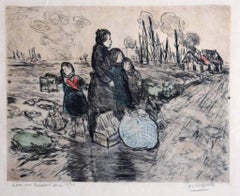André Dunoyer de Segonzac Art
to
4
15
3
1
4
15
3
17
1
Overall Height
to
Overall Width
to
12
2
11
11
6
5
5
3
2
2
2
2
1
1
18
2
6
2
1
2
4
18
6,938
3,292
2,514
1,213
11
5
5
4
2
Artist: André Dunoyer de Segonzac
original etching
By André Dunoyer de Segonzac
Located in Henderson, NV
Medium: original etching. This impression on wove paper was printed in 1968 and published in Paris for the Humanisme actif portfolio. Plate size: 8 1/4 x 6 inches (210 x 153 mm). Sig...
Category
1960s André Dunoyer de Segonzac Art
Materials
Etching
Saint Tropez
By André Dunoyer de Segonzac
Located in Fairlawn, OH
Saint Tropez
Etching with aquatint, printed in colors, 1964
Signed in ink and numbered in pencil
Edition: 71/100
Issued for the album St. Tropez et la Provence, in 1966
Reference: Lo...
Category
1960s Post-Impressionist André Dunoyer de Segonzac Art
Materials
Etching
"Boating on the Morin River"
By André Dunoyer de Segonzac
Located in Saint Amans des cots, FR
Pen, ink, watercolor and wash on paper by André Dunoyer de Segonzac, France, 1922-1924. Boating on the Morin River. Measurements : with frame: 52.5x65x2 cm - 20.7x25.6x0.8 inches / without frame: 36.5x45 cm - 14.4x17.7 inches. Signed lower left "A. Dunoyer de Segonzac". Colors may vary slightly depending on your screen. The lighter band at the top and the bottom of the piece, visible in the first picture, is only due to the reflection in the protective glass. It does not exist. In its frame gilt with gold leaf and its protective glass.
André Dunoyer de Segonzac was born in Boussy-Saint-Antoine (Essonne) July 7, 1884. After his schooling at high school Henri IV, as early as 1900, he attends classes at the National School of Fine Arts in Paris in free listener where he will befriend Charles Dufresne. In 1903, he enters the private studio of Luc-Olivier Merson. In 1907, he studies with Jean-Paul Laurens and attends the La Palette and Colarossi academies in Montparnasse. He meets Luc-Albert Moreau and Jean-Louis Boussingault with whom he shares a studio. His first drawings are published in 1908 in The Great Review and The Witness. Nearly indifferent to contemporary aesthetic revolutions, Dunoyer de Segonzac undertakes, with Jean-Louis Boussingault and Luc-Albert Moreau, to revive Gustave Courbet's realism by performing still lifes, nudes, landscapes, in a thick paste and masonry . In one of his letters to the painter Maurice Boitel, he wrote in the 1950s: "I have not forgotten the heroic period of the independents - when we were grouped around Paul Signac, the charming and valiant Maximilien Luce - in these barracks where the living and authentic Art was grouped outside the academic formulas - or literary and systematic tendencies - which were to lead to this abstract aesthetic of which the painting dies. "
In 1908, he begins exhibiting at the Salon d'Automne and the Salon des Indépendants, with Paul Signac and Maximilien Luce. He befriends Apollinaire, Max Jacob, Raoul Dufy and Vlaminck. From this period, renting a house belonging to Signac, Dunoyer discovers the landscapes of Saint-Tropez, to which he will remain faithful and where he lived until the end of his life. He stays in Saint-Tropez only in the summer season. For the rest, he leads a real nomadic life, in search of the motive especially through the Île-de-France, the Grand Morin valley, Feucherolles, Chennevières-sur-Marne, Guyancourt, etc. "I also worked a lot on the banks of the Seine in Chatou, Bougival, Andrésy, Poissy and Triel that I particularly like, with its beautiful Gothic church that is reflected in the Seine and the high wooded hills that surround him", he will say.
In 1910, he knows fashion designer Paul Poiret and meets Max Jacob, Raoul Dufy and Vlaminck. From 1910 to 1914, he travels to Italy, Spain, North Africa, and is interested in sport and dance (drawings of Isadora Duncan's Russian Ballets, 1911, The Boxers1910). From 1914 to 1918, mobilized in the infantry, he makes the war hardly, before being assigned to camouflage. He performs many war drawings, valuable for their artistic and documentary value.
From 1919, he appears again in many exhibitions, including major Parisian salons. Nearly indifferent to contemporary aesthetic revolutions, Dunoyer de Segonzac undertakes, with Boussingault and Moreau, to revive Courbet's realism by performing still lifes, nudes, landscapes, in a thick and masonry paste. Enlisted in engraving by Jean Émile Laboureur, he makes nearly 1,600 brass plaques from 1919 to 1970. He was president of the Society of French painters-engravers.
In 1921, he meets Paul Valéry, Léon-Paul Fargue and Jean Cocteau. In 1928, he makes a trip to America where he met with great success. In 1930, he becomes friend with Derain. In 1933 he receiveds the Carnegie Foundation of Pittsburgh Award and in 1934 the Venice Biennale.
During the Occupation, in November 1941, he takes part in a "study trip" to Germany, organized by Arno Breker, accepting, like other artists of the most renowned, to visit the hotspots of German culture as well as artist workshops.
After the war, he is exhibited in the best galleries...
Category
1920s Realist André Dunoyer de Segonzac Art
Materials
Paper, Ink, Watercolor, Pen
"Femme se maquillant" original etching
By André Dunoyer de Segonzac
Located in Henderson, NV
Medium: original etching. Published in Paris by Floury in 1929. This impression is printed on watermarked Lafuma wove paper. Plate size: 7 1/4 x 5 1/4 inches (185 x 135mm). Signed in...
Category
1920s André Dunoyer de Segonzac Art
Materials
Etching
Still Life With Bottles - Etching by André Dunoyer de Segonzac- 1950s
By André Dunoyer de Segonzac
Located in Roma, IT
Still Life With Bottles is an etching and drypoint realized by André Dunoyer de Segonzac (1884-1974) in the mid-20th Century.
Good condition on a yellowed paper.
Hand-signed by the artist on the plate.
Limited edition of 60 copies numbered and signed.
André Dunoyer de Segonzac (7 July 1884 – 17 September 1974) was a French painter and graphic artist.In 1947, he published his suite of etchings illustrating the Georgics of Virgil. In the judgement of Anne Distel, chief curator of the Musée d'Orsay, "The technical perfection and the nobility of the tone, which carried the cachet of the original, but was imbued throughout with an unfailing lyricism, make this work Segonzac's masterpiece. It must be included in a list of the most beautifully illustrated books of [the 20th] century."The gossamer quality of his etchings stood in contrast to the thickly painted surfaces and generally somber color of his oil paintings, which reflected his admiration for Courbet and Cézanne. His subjects include landscapes, still lifes, and nudes. He influenced other artists like Samuel Peploe...
Category
1950s Modern André Dunoyer de Segonzac Art
Materials
Etching
The Plow on the Fields- Etching by André Dunoyer de Segonzac- 1950s
By André Dunoyer de Segonzac
Located in Roma, IT
The Plow on the Fields is an etching and drypoint realized by André Dunoyer de Segonzac (1884-1974).
Good condition on a yellowed paper.
Hand-signed by the artist on the plate.
Limited edition of 60 copies numbered and signed.
André Dunoyer de Segonzac (7 July 1884 – 17 September 1974) was a French painter and graphic artist.In 1947, he published his suite of etchings illustrating the Georgics of Virgil. In the judgement of Anne Distel, chief curator of the Musée d'Orsay, "The technical perfection and the nobility of the tone, which carried the cachet of the original, but was imbued throughout with an unfailing lyricism, make this work Segonzac's masterpiece. It must be included in a list of the most beautifully illustrated books of [the 20th] century."The gossamer quality of his etchings stood in contrast to the thickly painted surfaces and generally somber color of his oil paintings, which reflected his admiration for Courbet and Cézanne. His subjects include landscapes, still lifes, and nudes. He influenced other artists like Samuel Peploe...
Category
1950s Modern André Dunoyer de Segonzac Art
Materials
Etching
Sergeant Infantry Trenches - Lithograph by A. D de Segonzac - Early 20th Century
By André Dunoyer de Segonzac
Located in Roma, IT
Sergeant Infantry Trenches is a Vintage Offset and Lithograph print realized by Dunoyer de Segonzac.
The artwork is in good condition on a yellowed paper.
Stamp signed and Titled on the lower margin.
André Dunoyer de Segonzac (7 July 1884 – 17 September 1974) was a French painter and graphic artist. The gossamer quality of his etchings stood in contrast to the thickly painted surfaces and generally somber color of his oil paintings, which reflected his admiration for Courbet and Cézanne. His subjects include landscapes, still lifes, and nudes. He influenced other artists like Samuel Peploe.
Category
Early 20th Century Modern André Dunoyer de Segonzac Art
Materials
Offset, Lithograph
Nu Accroupi - Original Etching by Dunoyer de Segonzac - 1930
By André Dunoyer de Segonzac
Located in Roma, IT
Image dimensions: 8 x 17 cm.
Etching on ivory colored paper, with en embossing stamp "Libreria Prandi Reggio E." in lower-right corner. Edition of 50 prints.
Beautiful etching rep...
Category
1930s Modern André Dunoyer de Segonzac Art
Materials
Etching, Drypoint
La colline de Sainte Anne - Original Etching by Dunoyer de Segonzac - 1925
By André Dunoyer de Segonzac
Located in Roma, IT
Image dimensions: 13 x 18 cm.
Etching on ivory colored paper.
Etching on ivory colored paper, with two embossing stamps: "Libreria Prandi Reggio E." in lower-right corner,"H. Peti...
Category
1920s Modern André Dunoyer de Segonzac Art
Materials
Etching, Drypoint
Bubu de Montparnasse - China Ink drawing - 1928/29
By André Dunoyer de Segonzac
Located in Roma, IT
Original China Ink drawing realized by Dunoyer de Segonzac as a sketch for the illustrations of the book "Bubu de Montparnasse" by Charles-Louis Philippe published in 1929 by Societé...
Category
1920s André Dunoyer de Segonzac Art
Materials
Ink
In Versum Distulit Ulmos - Original Etching by Dunoyer de Segonzac - 1944/47
By André Dunoyer de Segonzac
Located in Roma, IT
Hand signed. Edition of 200 copies.
This beautiful etching belongs to the series of illustrations that the French artist André Dunoyer de Segonzac realized for the "Georgics" by the...
Category
1910s Modern André Dunoyer de Segonzac Art
Materials
Etching, Drypoint
Le Blessé dans la Tranchée - Original Etching by Dunoyer de Segonzac - 1940s
By André Dunoyer de Segonzac
Located in Roma, IT
Hand signed. Edition of 75 prints.
Includes passepartout: 49x34 cm.
Very good conditions.
This artwork is shipped from Italy. Under existing legislation, any artwork in Italy creat...
Category
1940s Modern André Dunoyer de Segonzac Art
Materials
Etching, Drypoint
La Moisonneuse Endormie - Original Etching by D. de Segonzac - 1929
By André Dunoyer de Segonzac
Located in Roma, IT
Edition of 60 pieces, printed on verge ancient, numbered and signed by the artist in pencil.
Customs stamp on bottom left angle.
Good margins.
Ref. Cat. Lioré et Cailler 845.
Category
1920s Post-Impressionist André Dunoyer de Segonzac Art
Materials
Etching
Small Village - Stone lithograph - Mourlot 1965
By André Dunoyer de Segonzac
Located in Paris, FR
André Dunoyer de Segonzac
Small village
Stone lithograph in colors (printed in Atelier Mourlot)
Printed signature in the plate
On Arches vellum 38 x 28 cm (c. 15 x 11 in)
INFORMATI...
Category
1960s Modern André Dunoyer de Segonzac Art
Materials
Lithograph
André Dunoyer de Segonzac - La Mêlée - Original Etching
By André Dunoyer de Segonzac
Located in Collonge Bellerive, Geneve, CH
Charles Martin - La Mêlée - Original Etching
Dimensions : 13 x 10".
Paper : Rives vellum.
Edition : 225 copies.
1927
From Tableaux de Paris, Emile-Paul Freres, Paris
Category
1920s Modern André Dunoyer de Segonzac Art
Materials
Etching
Divine : Young Girl Hidden by the Curtains - Stone lithograph, 1930
By André Dunoyer de Segonzac
Located in Paris, FR
Andre DUNOYER DE SEGONZAC
Divine : Young Girl Hidden by the Curtains, 1930
Original stone lithograph
Unsigned
On Arches vellum 28 x 22 cm (c. 11 x 9 inch)
Excellent condition
Category
1930s Modern André Dunoyer de Segonzac Art
Materials
Lithograph
Province - Lithograph
By André Dunoyer de Segonzac
Located in Collonge Bellerive, Geneve, CH
(after) Dunoyer de Segonzac
Title: Province
Signed in the plate
Dimensions: 38 x 28 cm
from the edition of 250 as issued in Warnod, Andre, "Les Peintres mes amis" (Paris: Les Heures Claires, 1965)
André DUNOYER DE SEGONZAC (1884 - 1974)
André Dunoyer de Segonzac naît le 7...
Category
1960s Modern André Dunoyer de Segonzac Art
Materials
Lithograph
Le Blessé dans la Tranchée (variante 1) - Original Etching and Drypoint
By André Dunoyer de Segonzac
Located in Roma, IT
Hand signed. Edition of 75 prints.Original Prints.
From the suite: “Huit Illustrations de Guerre”.
Image Dimensions : 16.5 x 11 cm
This artwork is shipped from Italy. Under existing...
Category
1910s Modern André Dunoyer de Segonzac Art
Materials
Drypoint
Related Items
Rare Rodin Watercolour & Pencil on Paper of a Seated Nude - The Cambodian Dancer
By Auguste Rodin
Located in London, GB
Auguste RODIN (1840-1917)
Seated Nude, Cambodian Dancer
c. 1898 - 1900
Pencil and watercolour
11.5 x 9.3 inches;
25 x 20.5 inches, inc. frame
Provenance:
Christie's South Kensington: Wednesday, November 28, 2007
"It's very simple. My drawings are the key of my art."
Rodin was an extraordinary creative artist and a prolific worker. After attending the “Petite École”, he worked in the studio of the ornamentalist Albert-Ernest Carrier-Belleuse, first in Paris, then in Brussels, where his skill in handling decorative subjects fashionable in the 18th century became apparent. His discovery of Michelangelo, during a visit to Italy in 1875-76, was a decisive moment in his career. Rodin would, in turn, break new ground in sculpture, paving the way for 20th-century art, by introducing methods and techniques that were central to his own artistic aesthetics.
In 1906, King Sisowath of Cambodia visited France on an official state visit. It was on this visit that Rodin discovered the dancers of the Cambodian Royal Ballet and was inspired to draw and paint them over 150 times.
They made a deep impression on the artist, as he confided to Georges Bourdon, in an article for the newspaper Le Figaro on 1 August 1906: “There is an extraordinary beauty, a perfect beauty, about these slow, monotonous dances, which follow the pulsating rhythm of the music… [The Cambodians] have taught me movements I had never come across anywhere before…”
Originally seeing them in Paris he left everything suddenly to follow the dancers of the royal ballet to Marseille, from where they would embark on their return to Cambodia.
In just one week, he made about one hundred and fifty drawings, re-transcribing or interpreting the ballet poses, with an obvious fascination for the arms and hands of the dancers. These drawings were later highlighted with watercolour, creating coloured harmonies of a rare refinement.
The first performance of the Cambodian Royal Ballet took place in the context of the Colonial Exhibition in Marseille. Sisowath 1st had just been crowned King of Cambodia when he undertook the first trip ever to be made by a Cambodian sovereign to France, which had controlled Cambodia since June 1884. This official visit occurred at the height of French colonial expansion. Previously, the Universal Exhibition of 1900 had attracted 48 million visitors! The organisers realised what a tremendous impact this event made on the public, and it was soon adopted as the main tool for colonial propaganda. At the exhibition in Marseilles, the area devoted to Indochina was the largest of the seven sections.
When Auguste Rodin met the troupe of dancers for the first time in July 1906, during their brief visit to Paris for an exceptional performance at the Pré Catalan...
Category
19th Century Realist André Dunoyer de Segonzac Art
Materials
Watercolor
Le Petit Oiseau - Etching by Jean François Raffaelli - 1915
By Jean-Francois Raffaelli
Located in Roma, IT
Hand signed. Not numbered. With dedication to "Bernard" (1921).
Etching and aquatint technique. Perfect conditions.
Image Dimensions : 15 x 19 cm
Passepartout included : 35 x 50 cm
Category
1910s Post-Impressionist André Dunoyer de Segonzac Art
Materials
Etching
H 11.03 in W 14.38 in D 0.04 in
Maisons sur la Rivière, Canal à Nemours (Houses on the River, Nemours Canal)
By Henri Le Sidaner
Located in Saint Augustine, FL
Artist: Henri Le Sidaner (French, 1862-1939)
Title: "Maisons sur la Rivière, Canal à Nemours (Houses on the River, Nemours Canal)"
Portfolio: Revue de l'Art Ancien & Moderne
*Issued ...
Category
1920s Post-Impressionist André Dunoyer de Segonzac Art
Materials
Lithograph
La Balustrade (The Railing) /// Impressionist Henri Le Sidaner Landscape Garden
By Henri Le Sidaner
Located in Saint Augustine, FL
Artist: Henri Le Sidaner (French, 1862-1939)
Title: "La Balustrade (The Railing)"
Portfolio: Gazette des Beaux-Arts
*Issued unsigned, though signed by Sidaner in the plate (printed s...
Category
1910s Post-Impressionist André Dunoyer de Segonzac Art
Materials
Lithograph
Pavillon dans les Arbres (Pavilion in the Trees) /// Impressionist Henri Sidaner
By Henri Le Sidaner
Located in Saint Augustine, FL
Artist: Henri Le Sidaner (French, 1862-1939)
Title: "Pavillon dans les Arbres (Pavilion in the Trees)"
Portfolio: Henri Le Sidaner (Camille Mauclair)
*Issued unsigned, though signed by Sidaner in the plate (printed signature) lower left
Year: 1928
Medium: Original Etching on Rives BFK paper
Limited edition: Unknown
Printer: Unknown
Publisher: Galeries Georges Petit and Henri Floury, Paris, France
Reference: Bibliothèque Nationale No. 12
Sheet size: 11" x 8.38"
Image size: 9.25" x 7.13"
Condition: Some minor foxing on verso. It is otherwise a strong impression in excellent condition
Notes:
Printed in one color: bistre. Comes from Camille Mauclair's 1928 book publication "Henri Le Sidaner" which contained two bound original drypoint etchings by Sidaner. Comes with its original tissue cover...
Category
1920s Post-Impressionist André Dunoyer de Segonzac Art
Materials
Intaglio, Drypoint, Etching
Good Times I -- Couple Nude Figurative
By Weyman Lew
Located in Soquel, CA
Weyman Michael Lew is a painter and printmaker, born in San Francisco, California in 1935. Without over-mat, silver tone aluminum frame and plexi-glass. Imaqe, 22"H x 27"L.
He studied at the University of California, and the San Francisco Art Institute from 1965 to 1966 with Artist Mary Joan Jay DeFeo. His works are in the collection of De Young Memorial Museum; the Institution of Arte Contemporary in Lima, Peru; the Western American Artists...
Category
1970s American Modern André Dunoyer de Segonzac Art
Materials
Etching, Acrylic
Marseille : L'Estaque Landscape - Lithograph, 1972
By (after) Georges Braque
Located in Paris, FR
Georges BRAQUE (after)
Marseille : L'Estaque Landscape
Color lithograph after a painting
Printed signature in the plate
On Arches Vellum 50 x 65 cm (c. 20 x 26 inch)
Excellent con...
Category
1970s Fauvist André Dunoyer de Segonzac Art
Materials
Lithograph
Morning stretches
Located in Zofingen, AG
A quick live sketch is always a little imperfect - too little time and too much adrenaline in the blood at this moment, but it perfectly conveys the delight of beauty and, as the Fre...
Category
2010s Realist André Dunoyer de Segonzac Art
Materials
Paper, Tempera, Permanent Marker
18th C. Piranesi Fireplace Designs based on Ancient Architectural Styles
By Giovanni Battista Piranesi
Located in Alamo, CA
These two Giovanni Battista Piranesi 18th century etchings of fireplace designs on one sheet is plate 6 from his publication 'Diverse Maniere d'adornare i cammini ed ogni altra parte degli edifizi desunte dall'architettura Egizia, Etrusca, e Greca con un Ragionamento Apologetico in defesa dell'Architettura Egizia, e Toscana, opera del Cavaliere Giambattista Piranesi...
Category
Mid-18th Century Old Masters André Dunoyer de Segonzac Art
Materials
Etching
Katya
Located in Zofingen, AG
This is one of those sketches where Evgeniy Monahov first used an industrial marker together with tempera - the thick velvety black of his lines expands the tonal range of the delica...
Category
2010s Realist André Dunoyer de Segonzac Art
Materials
Permanent Marker, Tempera, Paper
Sunset - Ardgour
By Percival Gaskell
Located in Myrtle Beach, SC
Percival Gaskell, 'Sunset - Ardgour", aquatint, edition not stated, c. 1920. A superb, atmospheric impression, in brown/black ink, on cream wove paper; the full sheet with margins (2 to 3 inches), in excellent condition. Signed, titled, and numbered '2' in pencil. Matted to museum standards, unframed.
Ardgour is a district of Lochaber on Ardnamurchan peninsula on the western shore of Loch Linnhe...
Category
1920s Post-Impressionist André Dunoyer de Segonzac Art
Materials
Aquatint
Samuel Bak Surrealist Etching Israeli Bezalel Artist "Hidden Pear", Fruit Bowl
By Samuel Bak
Located in Surfside, FL
HIDDEN PEAR, color etching, signed in pencil, numbered 7/50, Jerusalem Print workshop blind stamp, image 7 ½ x 5 ½”, sheet 15 x 10 ¼”.
Samuel Bak (born 12 August 1933) is a Polish- American painter and writer who survived the Holocaust and immigrated to Israel in 1948. Since 1993, he has lived in the United States.
Samuel Bak was born in Wilno, Poland, Bak was recognized from an early age as having an artistic talent. He describes his family as secular, but proud of their Jewish identity.
By 1939 when Bak was six years old, the war began and Wilno was transferred from Poland to Lithuania. When Wilno was occupied by the Germans on June 24, 1941, Bak and his family were forced to move into the ghetto. At the age of nine, he held his first exhibition inside the Ghetto. Bak and his mother sought refuge in a Benedictine convent where a Catholic nun named Maria Mikulska tried to help them. After returning to the ghetto, they were deported to a forced labour camp, but took shelter again in the convent where they remained in hiding until the end of the war.
By the end of the war, Samuel and his mother were the only members of his extensive family to survive. His father, Jonas, was shot by the Germans in July 1944, only a few days before Samuel's own liberation. As Bak described the situation, "when in 1944 the Soviets liberated us, we were two among two hundred of Vilna's survivors--from a community that had counted 70 or 80 thousand." Bak and his mother as pre-war Polish citizens were allowed to leave Soviet-occupied Wilno and travel to central Poland, at first settling briefly in Lodz. They soon left Poland and traveled into the American occupied zone of Germany. From 1945 to 1948, he and his mother lived in Displaced Persons camps in Germany. He spent most of this period at the Landsberg am Lech DP camp in Germany. It was there he painted a self-portrait shortly before repudiating his Bar Mitzvah ceremony. Bak also studied painting in Munich during this period, and painted "A Mother and Son", 1947, which evokes some of his dark memories of the Holocaust and escape from Soviet-occupied Poland. In 1948, Bak and his mother immigrated to Israel. In 1952, he studied art at the Bezalel Academy of Arts and Design in Jerusalem. After serving in the Israel Defense Forces, he continued his studies in Paris (from 1956 at the École nationale supérieure des Beaux-Arts) and spent various periods of time in Rome, Paris, Switzerland and Israel before settling permanently in the United States. In 2001, Bak returned to Vilnius for the first time and has since visited his hometown several times. Samuel Bak is a conceptual artist with elements of post-modernism as he employs different styles and visual vernaculars, i.e. surrealism (Salvador Dali, Rene Magritte), analytical cubism (Picasso), pop art (Andy Warhol, Roy Lichtenstein) and quotations from the old masters. The artist never paints direct scenes of mass death. Instead, he employs allegory, metaphor and certain artistic devices such as substitution: toys instead of the murdered children who played with them, books, instead of the people who read them. Further devices are quotations of iconographical prototypes, i.e. Michelangelo's "Creation of Adam" on the Sistine Ceiling or Albrecht Dürer's famous engraving entitled "Melencholia" . In the late 1980s Bak opened up about his paintings, stating they convey “a sense of a world that was shattered.” He turns these prototypes into ironical statements. Irony in the art of Samuel Bak does not mean parody or derision, but rather disenchantment, and the attempt to achieve distance from pain. Recurring symbols are: the Warsaw Ghetto Child, Crematorium Chimneys or vast backgrounds of Renaissance landscape that symbolize the indifference of the outside world. These form a disturbing contrast with the broken and damaged images in the foreground. Samuel Bak's paintings cause discomfort, they are a warning against complacency, a bulwark against collective amnesia with reference to all acts of barbarism, worldwide and throughout the ages, through his personal experience of genocide.
In Bak's piece entitled Trains Bak creates a vast grey landscape with large mounts creating the structure of a train. Massive taper candles burn in the distance further down the train tracks, surrounding an eruption. The smoke from the candles and volcano pour into a sky of dark ominous clouds that lurk over the landscape. Here Bak has created a whole new meaning for “trains.” Many of Bak’s pieces incorporate aspects of Jewish culture and the holocaust with a dark and creative twist, such as Shema Israel, Alone, and Ghetto. Chess as a theme of life has always fascinated Bak. In the DP camps and in Israel, he often played chess with his stepfather Markusha. Underground II, 1997, portrays chess pieces in a sunken, subterranean evocation of the Vilna ghetto.
Select Group Exhibitions
Graphic Works by Contemporary Israeli artists - Israel Museum, Jerusalem
Avraham Ofek, Igael Tumarkin, Shmuel Bak, Avigdor Arikha,Jakob Steinhardt, Anna Ticho
Artist and Society in Israeli Art, Tel Aviv Museum, Tel Aviv Moshe Gat, Marcel Janco, Yohanan Simon, Ruth Schloss, Menashe Kadishman, Samuel Bak, Yosl Bergner.
Selected museum exhibitions
Bezalel Museum, Jerusalem, Israel – 1963
Tel Aviv Museum, Tel Aviv, Israel – 1963
Rose Museum, Brandeis University, Waltham, MA – 1976
Germanisches National Museum, Nuremberg, Germany – 1977
Heidelberg Museum, Heidelberg, Germany – 1977
Haifa University, Haifa, Israel – 1978
Kunstmuseum, Düsseldorf, Germany – 1978
Jüdisches Museum, Stadt Frankfurt am Main, Germany – 1993
Hebrew Union College, Jewish Institute of Religion, New York, NY – 1994
South African Jewish Museum, Cape Town, South Africa. 2013-2014.
B’nai B’rith Klutznick National Jewish Museum, Washington, DC – 1997
Holocaust Museum Houston, Houston, TX – 1997
National Museum of Lithuania, Vilnius, Lithuania – 2001
Felix Nussbaum...
Category
20th Century Surrealist André Dunoyer de Segonzac Art
Materials
Etching
André Dunoyer De Segonzac art for sale on 1stDibs.
Find a wide variety of authentic André Dunoyer de Segonzac art available for sale on 1stDibs. You can also browse by medium to find art by André Dunoyer de Segonzac in etching, drypoint, engraving and more. Much of the original work by this artist or collective was created during the 20th century and is mostly associated with the modern style. Not every interior allows for large André Dunoyer de Segonzac art, so small editions measuring 6 inches across are available. Customers who are interested in this artist might also find the work of Maurice Asselin, Edgar Chahine, and Yves Saint Laurent. André Dunoyer de Segonzac art prices can differ depending upon medium, time period and other attributes. On 1stDibs, the price for these items starts at $200 and tops out at $15,000, while the average work can sell for $665.
